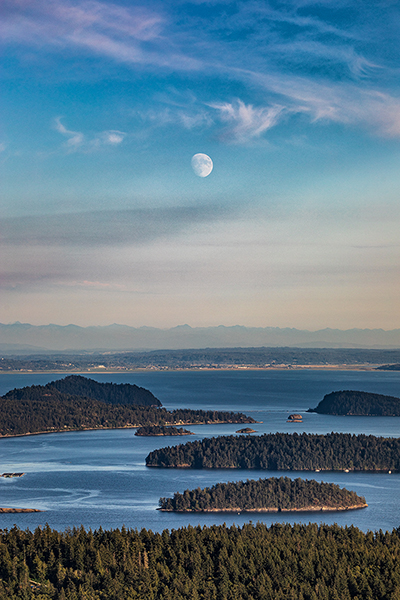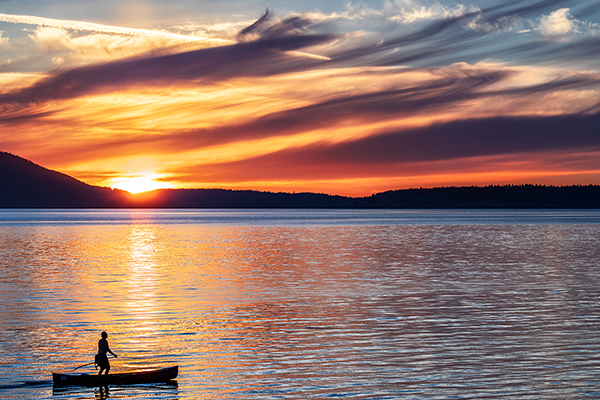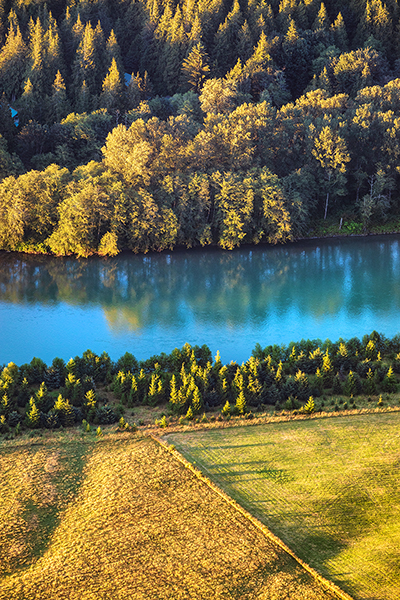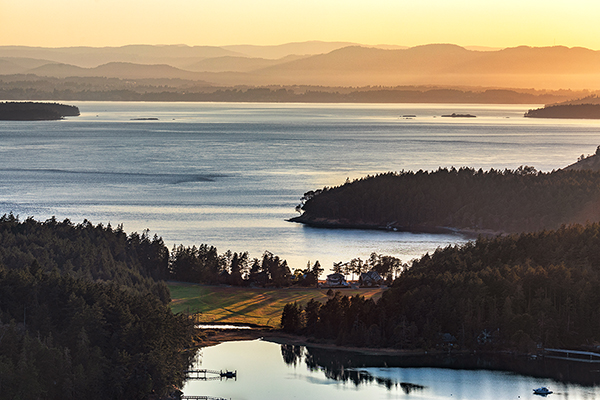Tamron Blogs
More Photo Tips | Video Gallery | Photo Gallery | Enewsletter sign-up
Tips for using a telephoto zoom lens for landscape photography
Text and Images by Taryn Rehn
TIP 1. Get to the site early. The best light is an hour before sunset/sunrise. Add extra time to find the best composition. I use a sun position app to preview where the sun will rise and set. That allows me to get positioned in the ballpark of the best sunset composition. Same approach for the moon. There are free smartphone apps that provide a live preview of where the moon will be in relation to landscape features. Just search for “sun path” and you’ll find the app.

150-600mm, 150mm, f/8, 1/400 sec., ISO 100
Click image to view larger
TIP 2. Be nimble. Move around and try different compositions when you first arrive at the scene. But only up to a certain point. Photography is all about timing, being prepared in the right place at the right time. I avoid moving around during key shooting times such as the last few moments of sunset or the beginning of moonrise. That would waste too much time restabilizing the tripod and risks missing the shot.

150-600mm, 300mm, f/8, 1/20 sec., ISO 100
Click image to view larger
TIP 3. Look for a story to tell. When I first started using the 150-600 telephoto lens it felt a bit restrictive compared to the standard zoom lens that I’m accustomed to. With the standard, I can capture wide swaths of landscape. By definition, the focus is narrowed with a telephoto lens. But after using the telephoto lens for a month my way of thinking was transformed. I realized how fun and empowering it is to be able to reach into a distant scene and extract a compelling visual narrative. Standard zoom lenses are great for conveying the big picture. But the telephoto lens is a more effective tool for storytelling, which is my main objective in photography. For the most part, my audience already knows what the iconic landscapes of the pacific northwest look like. So over time it’s become less about producing another mountain sunset and more about evoking the feelings and memories unique to the spirit of the place. The Tamron telephoto lens enables me to highlight a unique story that is unfolding at a given moment. With the standard zoom lens, I typically avoid people or human made objects. With the Tamron 150-600 telephoto lens I quickly learned the advantage of locations that are likely to have activity (human or wildlife) to add detail to the narrative. For my photography style, human activity is clutter in a panoramic view. But in a telephoto view it becomes a heartwarming vignette. It was a complete paradigm shift from preferring scenes devoid of manmade objects to seeking out locations with activity. The telephoto lens is a powerful tool for highlighting the beauty of those relatively up close and personal moments. Ask yourself, what’s the story and feeling I’m trying to convey? What do I want to remember about this moment that I haven’t seen or experienced before?

150-600mm, 150mm, f/8, 1/125 sec., ISO 100
Click image to view larger
TIP 4. Use a good tripod. The weight of a telephoto lens requires a sturdy, stable tripod, especially in low light situations. I upgraded to a carbon fiber tripod because my old tripod lacked the weight capacity.
TIP 5. Avoid vibration. Don’t set up on a boat, dock, or bridge that is subject to movement or vibration, unless you’re shooting at a very fast shutter speed (i.e., bright light conditions and/or higher ISO). Using a remote shutter control can also help reduce vibration for greater clarity. However, the auto focus didn’t work as well for me with the remote shutter, so I mainly used the live view touch screen focus to control shutter release. The light tap of a finger on the live view screen creates less vibration than pressing the button on the front of the camera body. Furthermore, I almost always use a 2 second delay on the shutter release so that any vibration from a finger tap is mitigated. However, that technique is not applicable to wildlife photography because animals tend to move. In that case you may need to freehand it or set the camera to automatic continuous shooting.
TIP 6. Don’t be afraid to turn up the ISO. I typically only shoot at 100 ISO to minimize noise in the image. But with a telephoto lens, while trying to capture wildlife images at sunset, I believe it’s better to increase ISO and have a hint of grain than to have blur from vibration. I went up to 800-1600 ISO and the photos are perfectly fine for web and medium size print.
TIP 7. Experiment with landscape and portrait. One of the things I enjoyed about the Tamron lens is that it comes with a tripod mount that allows me to rotate the camera into portrait mode without using the ball socket rotation on the tripod. It’s a much quicker way to switch between landscape and portrait orientation. Be sure that VC is switched to “on” or it might not work properly in portrait mode. For a long time, I shot exclusively in portrait mode but lately I’ve switched to landscape and crop it into two portrait vignettes. The key is to experiment with both and find your personal style.

150-600mm, 300mm, f/8, 1/4 sec., ISO 100
Click image to view larger
TIP 8. Shoot in Raw image format. I typically need to do some image sharpening in Photoshop or Lightroom. A few years ago, I rented a top-of-the-line telephoto and was surprised to learn that photos taken over 100mm are improved by sharpening in the photo editing program of your choice. When shooting objects at a great distance, atmospheric haze begins to reduce the sharpness of the image. Atmospheric haze is natural and always present. It’s part of the reason the trees in the distance look faded and lack detail when viewed with the naked eye. No matter how good the lens is, it can’t completely overcome that natural effect, especially when there’s high humidity, smoke, or smog in the air. Do a bit of sharpening using one of the clarity or dehaze tools in Photoshop and watch the detail come to life! But don’t overdo it or the result could look too granular and unrealistic.

150-600mm, 300mm, f/8, 1/50 sec., ISO 400
Click image to view larger
TIP 9. Natural high. One of the best ways to maximize the potential of a telephoto lens is to go to a high vantage point and photograph the scene below. Some of my favorite shots are looking down at farms and homesteads in the river valley or along the shores of the Puget Sound. If your local terrain is flat, try a lookout tower or an urban context such as the roof deck of a high rise building or the upper seats in a stadium.

150-600mm, 150mm, f/8, 1/125 sec., ISO 100
Click image to view larger
See more of Taryn’s work on Instagram at @tarynrehn
More Photo Tips | Watch Videos | Learn More About Tamron Lenses | Photo Gallery